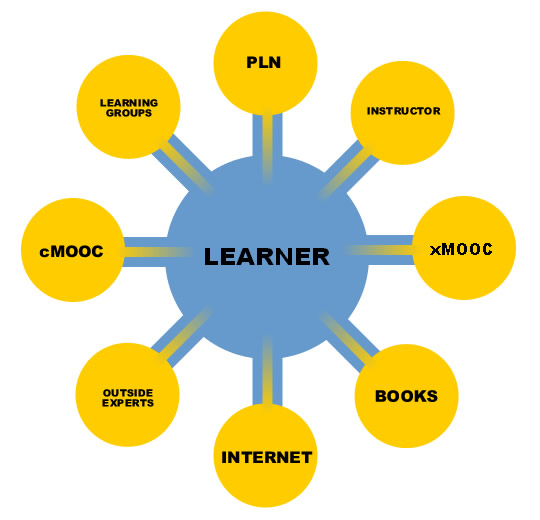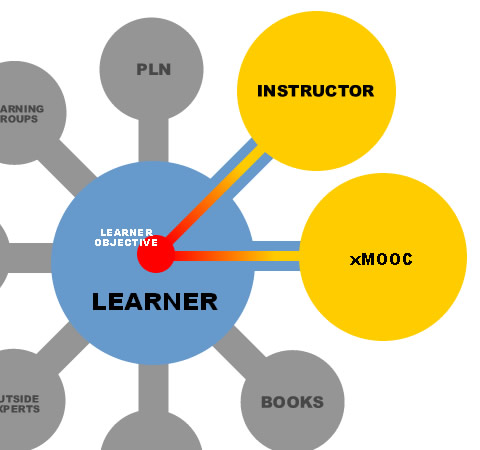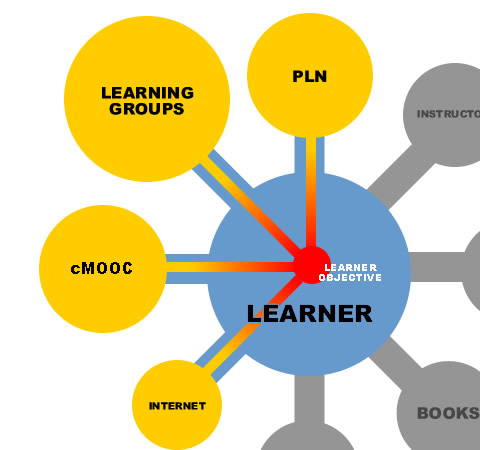So I want to take a step back and look at a bigger picture for a moment. The previous diagram I created was meant as more of a “learner design” perspective, in the sense that the dual paths would be the two main possibilities for learners. This was meant to look at the course from the eyes of a learner. But, the diagram breaks down in many ways since this will not be a traditional course. This course will attempt to deconstruct what it is to learn, be a learner, and to move through a course.
There has been a lot of really good feedback on the diagrams. Mike Caufield makes a great suggestion for considering the idea of federation in this course. I’ll have to figure that one out some more and unpack that in another post. I want to zero in on a few big design considerations first.
Stephen Downes asked “But is that really distributed, the way a cMOOC would be? At a certain point, the movement to collect people into single-site courses collides with the movement toward things like indieweb and reclaim your domain.” Good questions, and very true. The main idea behind this dual design is to be distributed, and that is where my diagram starts to break down if you examine it closely enough. At some point, we probably will need to look at several things and decide between collected and distributed. Not that we will want to, but there will be time and technology constraints to consider, and then on top of that many thousands of people that are used to the collected, silo approach to learning will need scaffolding to get out of that mindset.
But the goal is to dismantle, deconstruct, and distribute as much as possible. Unfortunately, I did not capture that well in the diagram.
So let me look at this based on some other questions. Many have asked good questions about how competencies will work across xMOOCs and cMOOCs, as well as how the software for cMOOCs and xMOOCs can be connected in ways that connects designs that don’t fit together. All of these are good questions, and reveal how we will have to look at design in a vastly different way than we do in traditional classes and even many MOOCs.
Most of our design methods follow an ADDIE-ish structure that focuses on defining learner paths, pre-set competencies/objectives, pre-defined outcomes, and collected silo approaches. For this class, my goal is to transition from learner design to learning design. Instead of looking at what each path will look like, what content students will consume, what artifacts they will create, etc, we will need to plop the learner down at the middle of a fluid diagram and then place all of the parts around the learner. Instead of equal and opposite paths with xMOOCs and cMOOCs and instructors and books, we see a learner surrounded with many tools that they can choose as they so desire. Like this:

These parts are all possibilities that the learner can choose from to meet their chosen competencies – but what they use is up to them at any given point (I only put a few examples above – there are many others). Therefore, the design for the class could be more along the lines of giving the learner freedom to choose how they prove they learned what they claim to have learned.
Think of this in the sense of objectives. To have a good objectives, one model is to write a sentence with conditions, behaviors, and criteria. For example:
Using Tableau (CN), the learner will analyze the sample data (B) with at least 90% accuracy (CR).
This is how we typically create objectives in traditional learning. However, the sample data might be meaningless to most learners, and some learners may think 90% is too low while others might be new and think it is too high. To deconstruct this approach to writing objectives, you would start to put in many more blanks:
Using Tableau (CN), the learner will __________________ (B) by ___________________ (CR).
Those blanks would be filled in by students during class. This is the basic idea behind the assignment bank that ds106 uses very effectively. Let the learner set their own objectives and competencies and then let the learner choose how to demonstrate mastery. To do so, the learner might focus heavily on more instructivist resources to meet their objectives, like this:

Or, the learner may focus more on cMOOC resources to meet their objectives, like this:

Notice that not all of the aspect available are used, and even those that are used are not equally utilized. Additionally, these diagrams would not stay static through the whole course – they would morph over time to meet different objectives and competencies as they morph over time. If I had time, this would be better demonstrated by an animation that morphs through several versions as the class progresses. Keep in mind, this is in conjunction with the tubing metaphor of group formation (for those students that choose to have groups) as well as the dual pathways diagram. This is just another abstraction of different aspects.
This would also mean that the various software solutions would only need to be able to connect user accounts across systems and then export artifacts as needed. In other words, we don’t have to worry about how a paper submitted for “Week 1” to EdX can be connected with a blog post for “Week 1” on WordPress or how a discussion response on Facebook can be connected to a Tweet that also responds to the question. We just need to connect the user accounts from EdX and WordPress and Twitter and Tumblr with an account on a central profile (on something like ProSolo). These connected accounts would just need to be able to send out what ever artifact the student wants to use to prove they know the topic. This central profile would not necessarily collect and silo these artifacts, but would link to distributed artifacts. This could be then used for portfolios, badges, certifications, etc. All of this work could be individual or group based (as long as groups come together around shared objectives).
Again, none of this is new stuff – these are all ideas that others have explored. The main goal is to keep this all distributed and open. Anywhere where it doesn’t sound like that is probably just a break down in my explanation. But I need people pointing that out to help clarify and improve the design before we move into production. And I apologize where I had to gloss over some detailed complexities in order to just get to the point. But this is an idea in progress, and I have a bad habit of explaining something and then blowing it up the next day because I found a problem with it :)
Matt is currently an Instructional Designer II at Orbis Education and a Part-Time Instructor at the University of Texas Rio Grande Valley. Previously he worked as a Learning Innovation Researcher with the UT Arlington LINK Research Lab. His work focuses on learning theory, Heutagogy, and learner agency. Matt holds a Ph.D. in Learning Technologies from the University of North Texas, a Master of Education in Educational Technology from UT Brownsville, and a Bachelors of Science in Education from Baylor University. His research interests include instructional design, learning pathways, sociocultural theory, heutagogy, virtual reality, and open networked learning. He has a background in instructional design and teaching at both the secondary and university levels and has been an active blogger and conference presenter. He also enjoys networking and collaborative efforts involving faculty, students, administration, and anyone involved in the education process.
I’m interested in and appreciate the out loud thinking you are doing to design a course experience that is not a singular repeated experience for participants.
I do wonder though, about the assumptions in a “dual” layer, and for that matter, that there are well defined entities of xMOOCs and cMOOCs– not to get into a definition war (which I loathe), but I’ve seen xMOOCs that have a lot of cMOOC like activity, and bet there are cMOOCs that have a strong “intructivist” design.
The labels really do not mean much to students, laypeople, only ed tech wonks, investors, and media sharks (for the short term). I frankly wish they were never coined.
It’s almost tempting to reaching for some kind of MOOC Uncertain Principle, that we can only have a probability function that suggests where an experience may lie, they are both ill-defined subsets of networked learning experiences.
A distributed system of activities that students might do is a way to go (and what the heck is ProSolo? I only found car racing and musical instrument sites), but I wonder too if we need more than a central index of linked pieces of work? And do artifacts really prove knowing topics? And is knowing topics really what one is trying to achieve?
“what ever artifact the student wants to use to prove they know the topic.”
The downfall to me is this idea that a system does all this stuff to measure and show and badge learners (it makes it almost a passive experience). It’s not without value, but shouldn’t we also be putting as much onus on learners to be able to construct their own evidence of work, to be able to craft their own demonstrations of what they can do. It’s almost like we expect students to just be badged, while they should also be badging themselves.
I have no clue as to the content or mode of the course, but I suspect it is a lot of focus on covering content. Yes, there are foundational aspects that people need as an understanding (I am guessing) to conduct analyses of measures of learning, but wouldnt it be much better if they are *doing* real analytics (and not just the rote kind of data munching stuff I saw in a data visualization coursera course I fell out of)— what if they worked on real data, real courses, with real teachers, solving or trying to solve, real problems?
Wouldn’t it be better for participants to be able to demonstrate applying these skills rather than “proving they know topics”? Wouldn’t it be better if participants can articulate and present their work in a way that is meaningful to them?
Sorry if I am throwing out vague wild tosses- there is way more than I don’t know with your course development than I do.
Yeah, its always hard to blog about things that are so abstract – at times you are going to just choose words that don’t really convey what you are thinking. Also, a lot can be said about how I don’t spend a lot of time spelling out my own ontology and epistemology. For me, you don’t really know a topic until you have proven that you can apply it. You wouldn’t waste time on sample data – you would use your real data as much as possible. There wouldn’t be a badge unless the student had constructed their own proof of learning. And so on and so forth. So, in a round about way, I am saying I agree with everything you say and apologize for my word choices in describing it. Some of that was intentional – I know that most people that read this blog are completely new to a social constructivist / de-siloed way of design, so I have to scaffold them into these topics by using concepts they are used to hearing. Some of the paragraphs here are thoughts that I had while pondering questions that people on the design team had, so they probably reflect more of the language of the original question than what I intended.
But, its important to point these issues out to me so that I make sure to use better language going forward. Ultimately, those descriptions can inform design choices in small and large ways.
ProSolo is a cool program George and Dragen are working on that I think might be the first real Learning Management System I have ever seen. I say that because it allows learners to set their own learning competencies, form groups around those, and then construct their own evidence of work and share it with whoever they like. I don’t think it has been widely released, so I’m not even sure if I am supposed to be talking about it here or not :)
Also, I should point out that we are trying to deal with the reality that many people will want to take this course and just learn the content, pass the test, get the badge or whatever and be done. Yes, that’s very passive and I would personally want to push them to do more active construction, but that may not work. What George Siemens has been saying is that he wants multiple pathways through the course so that people can learn how they want, regardless of whether we think it is the right way or not. So, that will be probably the biggest challenge for myself and others on the project – figure out a way to allow different expressions of learning to occur in the same course, even if those expressions represent radically different epistemologies that are incompatible.
Nice idea, mapping out the c an x MOOC functions. It looks to me though that the x ‘tail’ always wags the c ‘dog’. In a sense the c route is just temporary diversion.
That’s fine, the demands for prescriptive learning must be met.
I have tweeted a number of times (aka ‘dustcube’) on ‘the new learning paradox: the open/course’ and it remains interesting because it will (from now on) always be a paradox.
In our research group we have tried to move the ‘mapping’ exercise on a bit, and make it more dynamic, so that both the learner and the designer can track how the interaction between the constraints of the course, and the freedom of openness develop as it all proceeds. See the open wiki: http://footprints-of-emergence.wikispaces.com/ for more details and examples of ‘dynamic mapping’. And see the related wiki: http://learning-affordances.wikispaces.com/Probes for some ideas of dynamic tools, as ‘probes’.